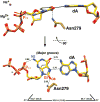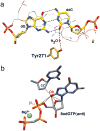Mutagenic conformation of 8-oxo-7,8-dihydro-2'-dGTP in the confines of a DNA polymerase active site
- PMID: 20526335
- PMCID: PMC2921931
- DOI: 10.1038/nsmb.1852
Mutagenic conformation of 8-oxo-7,8-dihydro-2'-dGTP in the confines of a DNA polymerase active site
Abstract
The major product of oxidative base damage is 8-oxo-7,8-dihydro-2'-deoxyguanine (8odG). The coding potential of this lesion is modulated by its glycosidic torsion angle that controls whether its Watson-Crick or Hoogsteen edge is used for base pairing. The 2.0-A structure of DNA polymerase (pol) beta bound with 8odGTP opposite template adenine indicates that the modified nucleotide assumes the mutagenic syn conformation and that the nonmutagenic anti conformation would be incompatible with efficient DNA synthesis.
Figures


References
-
- Ames BN, Gold LS. Mutat Res. 1991;250:3–16. - PubMed
-
- Kouchakdjian M, et al. Biochemistry. 1991;30:1403–1412. - PubMed
-
- McAuley-Hecht KE, et al. Biochemistry. 1994;33:10266–10270. - PubMed
-
- Maki H, Sekiguchi M. Nature. 1992;355:273–275. - PubMed
-
- Beard WA, Wilson SH. Chem Rev. 2006;106:361–382. - PubMed
Publication types
MeSH terms
Substances
Associated data
- Actions
Grants and funding
LinkOut - more resources
Full Text Sources
Miscellaneous

